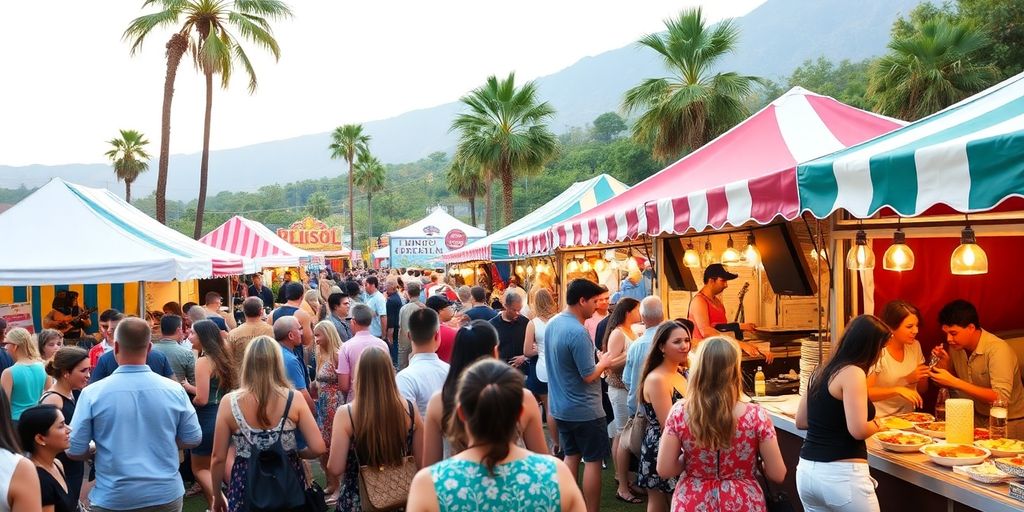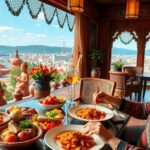Local festivals can be a blast, but what if you could experience them with a twist of exclusivity and privacy? Attending private cultural festivals allows you to enjoy unique events without the crowds, offering a more personal touch. From intimate gatherings to curated experiences, these festivals are becoming increasingly popular, and they cater to those looking for something special. Let’s explore what makes these private cultural festivals stand out and how you can make the most of them.
Key Takeaways
- Private cultural festivals offer a more exclusive and intimate experience compared to larger events.
- These festivals often feature limited attendance, allowing for a more enjoyable and personalized atmosphere.
- Wellness activities and relaxation spaces are becoming common, promoting mental and physical health at festivals.
- Technology plays a significant role, enhancing experiences with features like RFID access and mobile apps.
- Sustainability is key, with many private festivals focusing on eco-friendly practices and supporting local artisans.
Exploring Private Cultural Festivals
Understanding the Concept of Private Festivals
Private cultural festivals? What are those, even? Well, think of them as the cooler, more exclusive cousins of your typical music fest or town fair. They’re all about creating a unique, intimate experience that you just can’t get at a massive public event. These festivals often focus on specific themes or cater to niche interests, making them a draw for people who are really passionate about something. It’s not just about the event itself, but also about the community it creates.
Benefits of Attending Exclusive Events
Okay, so why bother trying to get into one of these exclusive shindigs? For starters, the crowds are way smaller. No more fighting your way through hordes of people just to get a glimpse of the stage. You get better access, better views, and a much more relaxed vibe. Plus, these events often have higher-quality food, drinks, and amenities. Think gourmet food trucks instead of greasy carnival fare. It’s a whole different level of experience. You might even find private art tours that deepen your appreciation of art.
Here’s a quick rundown of the perks:
- Less crowded venues
- Higher quality food and drinks
- More personalized experiences
- Unique networking opportunities
The best part? You’re more likely to meet people who share your interests. These festivals tend to attract a like-minded crowd, making it easier to strike up conversations and make new friends.
How to Find Private Cultural Festivals
Finding these hidden gems can be a bit of a challenge, but it’s totally doable. Start by doing some digging online. Look for niche communities or organizations that host events related to your interests. Social media can also be a goldmine. Follow relevant hashtags and accounts to stay in the loop. Word of mouth is huge, too. Talk to people in your network and see if they know of any upcoming events. Sometimes, it’s all about who you know. Don’t be afraid to ask around! You might even stumble upon Antarctic private expeditions for a truly unique experience.
Creating Intimate Festival Experiences

Limited Capacity for Enhanced Enjoyment
Okay, so picture this: you’re at a festival, but instead of being crammed in like sardines, you actually have room to breathe. That’s the magic of limited capacity. It’s all about quality over quantity. Smaller crowds mean shorter lines for food, drinks, and, yes, even the dreaded porta-potties. Plus, you can actually see the stage without having to fight your way through a sea of people. It’s a game changer.
Curated Artist Lineups for Unique Vibes
Forget the generic, radio-friendly acts. Intimate festivals thrive on curated lineups. Think carefully selected artists that complement each other, creating a cohesive and unique vibe. It’s not just about booking big names; it’s about creating an experience. This is where you can really find niche interests within your target market and tailor the event accordingly.
Personalized Touches to Elevate Experiences
It’s the little things that make a big difference. Personalized touches can really elevate the festival experience. I’m talking about things like:
- Welcome gifts for attendees
- Handwritten notes with schedules
- Customized food and drink options
These small gestures show attendees that you care about their experience and are willing to go the extra mile to make them feel special. It’s about creating a sense of community and belonging, making the festival more than just a music event, but a memorable experience. Consider offering exclusive wildlife encounters to make the experience even more special.
Here’s a quick look at how personalized touches can impact attendee satisfaction:
| Touchpoint | Impact |
|---|---|
| Welcome Gift | Increased sense of value |
| Customized Options | Enhanced feeling of being understood |
| Personal Attention | Stronger connection to the event |
Wellness and Mindfulness at Festivals
Integrating Health Activities into Events
Festivals are starting to realize that people want more than just music and partying. Adding health and wellness activities is becoming a big thing. You’ll see yoga sessions popping up everywhere, meditation workshops, and even fitness classes. It’s a way to balance out the crazy energy of the music with some chill time and self-care. I went to one festival last summer that had morning yoga overlooking the main stage – it was actually pretty awesome, even though I’m not usually a yoga person.
- Yoga and meditation sessions
- Fitness classes (Zumba, HIIT, etc.)
- Nutritional food vendors
It’s not just about physical health, either. These activities can really help with mental clarity and stress reduction, which is something a lot of people need at a festival.
Creating Relaxation Spaces
Sometimes you just need to get away from the noise and the crowds. That’s where relaxation spaces come in. These are areas set up specifically for people to chill out and recharge. Think quiet zones with comfy seating, maybe some calming music, and definitely a place to escape the sun. I remember one festival had a whole tent filled with beanbag chairs and soft lighting – it was a lifesaver after a few hours of dancing in the heat. These spaces are becoming more important as festivals get bigger and more intense. Consider adding luxury wildlife encounters to your relaxation routine.
- Quiet zones with comfortable seating
- Shaded areas with hammocks or cushions
- Designated areas for meditation or mindfulness exercises
Promoting Mental Well-being Through Festivals
Mental health is finally getting the attention it deserves, and festivals are no exception. Some festivals are now offering on-site counselors, support groups, and even just quiet spaces where people can go if they’re feeling overwhelmed. It’s a big step in the right direction. I think it’s really important for festivals to acknowledge that these events can be intense, and to provide resources for people who might be struggling. It’s not just about having fun; it’s about taking care of yourself and each other. You can even find personalized art tours to help you relax.
- On-site counselors or therapists
- Support groups or peer support networks
- Information about mental health resources
The Rise of Boutique Festivals
Characteristics of Boutique Festivals
Boutique festivals are all the rage right now, and for good reason. They’re not your typical massive, overcrowded events. Instead, they focus on creating a more intimate and curated experience. Think smaller crowds, unique settings, and a whole lot of attention to detail.
- Limited attendance, usually capped to maintain exclusivity.
- Unique locations, often in scenic or unconventional spots.
- Emphasis on high-quality production and design.
Boutique festivals are really about quality over quantity. It’s about creating a memorable experience for everyone involved, from the attendees to the artists.
Why Attendees Prefer Smaller Events
People are increasingly drawn to smaller festivals because they offer something bigger events often can’t: a sense of community and connection. You’re not just a face in the crowd; you’re part of a more tight-knit group. Plus, shorter lines for food and bathrooms are always a win! The shift in music festival ticket sales to last-minute buying patterns is also influencing the rise of boutique festivals, as organizers can better manage smaller crowds and adapt to changing preferences.
- More intimate atmosphere.
- Less crowded, more comfortable experience.
- Greater opportunity for interaction with artists and other attendees.
Niche Themes and Their Appeal
One of the coolest things about boutique festivals is their ability to cater to specific interests. Whether you’re into bluegrass, electronic music, or even a specific type of yoga, there’s probably a boutique festival out there for you. This specialization allows for a deeper connection with the event and the people who attend. For example, you can find exclusive animal encounters at some niche festivals, blending unique experiences with luxury travel. Themed events are gaining traction, with many attendees seeking new luxury travel experiences that align with their passions.
- Cater to specific genres or interests.
- Create a more immersive and engaging experience.
- Attract a dedicated and passionate audience.
Technology’s Role in Private Festivals

Utilizing RFID for Exclusive Access
RFID (Radio-Frequency Identification) tech is changing how private festivals handle access and payments. Think of it as a super-smart wristband. Instead of fumbling with tickets or cash, attendees can breeze through entry points and make purchases with a simple tap. This not only speeds things up but also adds a layer of security, preventing unauthorized access. Plus, organizers can gather data on attendee movement and spending habits, helping them improve the festival experience in real-time. It’s a win-win for everyone involved. For example, cashless payments are now easier than ever.
Mobile Apps for Enhanced Experiences
Mobile apps are becoming essential for private festival attendees. They’re not just digital schedules anymore; they’re interactive guides that put everything at your fingertips.
- Personalized schedules based on your favorite artists
- Interactive maps to help you find your way around
- Real-time updates on set times and surprise performances
A well-designed festival app can significantly improve attendee satisfaction. It reduces the need for printed materials, keeps everyone informed, and allows for instant feedback. It’s like having a personal assistant dedicated to making your festival experience as smooth as possible.
Some apps even offer features like pre-ordering food and drinks, connecting with other attendees, and participating in interactive games. It’s all about creating a more immersive and engaging experience. Don’t forget to check out bespoke island-hopping experiences.
Virtual Reality and Augmented Reality Integration
VR and AR are starting to make waves in the private festival scene. While not yet mainstream, they offer exciting possibilities for enhancing the experience. Imagine being able to preview a performance in VR before it even happens, or using AR to unlock hidden content and interactive experiences around the festival grounds.
Here’s how VR/AR could be used:
- Virtual stages for remote attendees
- AR overlays that provide information about artists or installations
- Interactive games that blend the real and virtual worlds
These technologies can add a whole new dimension to the festival experience, making it more memorable and engaging. It’s all about pushing the boundaries of what’s possible and creating something truly unique.
Sustainability in Private Cultural Festivals

Eco-Friendly Practices for Event Organizers
Okay, so, running a festival and trying to be good to the planet? It’s a thing now. More and more people actually care if you’re trashing the place or trying to keep it clean. One big thing is cutting down on waste. Think about it: all those cups, plates, and wrappers add up fast.
- Use compostable stuff. It breaks down, which is way better than plastic hanging around forever.
- Set up recycling bins everywhere. Make it easy for people to toss their trash in the right spot.
- Work with vendors who are also eco-conscious. They can help you keep things green.
It’s not just about looking good; it’s about doing the right thing. Plus, people notice when you’re making an effort. It can actually make your festival more popular.
Community Engagement Through Sustainability
Sustainability isn’t just about what you do at the festival; it’s about getting the community involved. Partnering with local groups can make a huge difference. Maybe a local environmental club can help with cleanup, or a nearby farm can supply food. It’s a win-win. You get help, and they get exposure. Think about setting up workshops or talks about sustainability. Teach people something new. It makes the festival more than just a party; it makes it an experience. You can even offer meet-and-greets with artists who are passionate about environmental issues.
Promoting Local Artisans and Vendors
Forget the mass-produced junk. People want unique stuff, and they want to support local businesses. So, bring in artisans and vendors from the area. It adds character to the festival, and it helps the local economy. Plus, it’s way more interesting than the same old stuff you see everywhere else. Make sure they’re using sustainable practices too. It all ties together. You could even create a special area just for local vendors, like a private retreat within the festival.
Here’s a quick example of how you might structure vendor fees to encourage local participation:
| Vendor Type | Fee (Local) | Fee (Non-Local) |
|---|---|---|
| Food Vendor | $200 | $500 |
| Craft Artisan | $100 | $300 |
| Information Booth | Free | $100 |
By prioritizing local vendors, you not only reduce the environmental impact of transportation but also contribute to the economic well-being of the community. It’s a simple change that can make a big difference. You can also promote private expeditions to local farms or artisan workshops as part of the festival experience.
Building Community at Festivals

Festivals are more than just events; they’re opportunities to build lasting connections. It’s about creating a space where people feel like they belong and can share experiences. Let’s look at how to make that happen.
Fostering Connections Among Attendees
Creating a welcoming environment is key. Think about ways to help people meet and interact. A simple thing like having communal seating areas can make a big difference. You could also organize icebreaker games or group activities to get people talking. Consider a "Festival Buddy" system, pairing newbies with experienced attendees to help them navigate and feel more comfortable. This not only aids newcomers but also sparks lasting friendships. Use a ticketing system to identify first-time buyers and facilitate these connections.
Utilizing Social Media for Engagement
Social media is a powerful tool for building community before, during, and after the festival. Create an official event hashtag and encourage attendees to share their experiences. Run contests or giveaways to incentivize participation. Consider using a platform to create a private online group where attendees can connect, share photos, and discuss their favorite moments. It’s a great way to keep the festival spirit alive year-round. Many festivals now use custom apps that allow attendees to connect before, during, and after the event. These apps often include features like group chats, meetup coordination, and shared playlists.
Creating Themed Areas for Interaction
Themed areas can be a fun way to bring like-minded people together. For example, a "Sustainable Living" zone could feature workshops on eco-friendly practices and attract environmentally conscious attendees. A gaming area could offer tournaments and casual play, appealing to gamers. These spaces provide a natural conversation starter and help people find others with similar interests. Consider interactive art installations that encourage participation and social media sharing.
Building a strong community leads to increased loyalty and repeat attendance. Encourage attendees to share their experiences on social media using event-specific hashtags, and consider creating a year-round online community where festival-goers can stay connected between events.
Here’s an example of how themed areas can boost engagement:
| Themed Area | Activities | Target Audience |
|---|---|---|
| Arts & Crafts Zone | Workshops, live demonstrations, vendors | Creative individuals |
| Gaming Lounge | Tournaments, free play, VR experiences | Gamers, tech enthusiasts |
| Wellness Garden | Yoga, meditation, healthy food vendors | Health-conscious attendees |
Don’t forget to promote these areas through your private art tours and event materials!
Challenges for Festival Organizers
Weather Considerations and Planning
Weather can really make or break a festival. Having a solid backup plan is super important. Think about it: rain, extreme heat, or even unexpected cold snaps can impact attendance and the overall vibe.
- Have backup indoor venues or covered areas.
- Monitor weather forecasts closely leading up to and during the event.
- Communicate weather-related updates to attendees in real-time through a mobile app or announcements.
It’s not just about having a tent; it’s about thinking through how weather impacts everything from power supply to ground conditions. Muddy fields aren’t fun for anyone, and neither is a stage that’s lost power because of a storm.
Adapting to Changing Audience Preferences
What people want from a festival is always changing. Keeping up with trends is key. What was cool last year might be totally outdated now.
- Pay attention to what’s popular on social media and in music charts.
- Survey attendees after each event to get feedback on what they liked and didn’t like.
- Be willing to experiment with new types of experiences, like wellness activities or interactive art installations. Consider offering bespoke travel experiences to cater to diverse interests.
Managing Costs While Maintaining Quality
Running a festival can be expensive. Balancing the budget with the desire to create an awesome experience is a tough act. You don’t want to cut corners so much that the festival loses its appeal, but you also need to stay in the black.
- Negotiate with vendors and suppliers to get the best possible prices.
- Explore sponsorship opportunities to offset costs.
- Use data analytics to optimize ticket pricing and marketing spend. Consider offering private expeditions for a premium experience.
Here’s a simple table showing potential cost areas and strategies for managing them:
| Cost Area | Management Strategy |
|---|---|
| Artist Fees | Negotiate contracts, book emerging talent |
| Venue Rental | Explore alternative locations, negotiate rates |
| Marketing | Targeted online ads, social media campaigns |
| Security & Staffing | Efficient scheduling, volunteer programs |
| Infrastructure | Rent equipment, explore cost-effective alternatives |
It’s a constant balancing act, but with careful planning and a bit of creativity, you can create a memorable festival without breaking the bank. Consider offering island-hopping experiences to attract a high-end clientele and increase revenue.
Case Studies of Successful Private Festivals
Highlighting Unique Festival Experiences
Let’s look at some private festivals that really nailed it. These aren’t your average, run-of-the-mill events; they’re carefully crafted experiences that leave attendees wanting more. Think beyond just music – it’s about creating a whole vibe.
- The Secret Garden Party (UK): Known for its immersive art installations and a strong emphasis on participation, this festival creates a world of its own. It’s not just about watching; it’s about being part of the art.
- Further Future (US): This event blends technology, music, and wellness in the Nevada desert. It’s a place where you can hear cutting-edge electronic music, attend workshops on sustainable living, and stargaze all in one weekend.
- Festival No.6 (UK): Set in the quirky village of Portmeirion, this festival combines music, arts, and culture in a stunning architectural setting. The location itself is a huge draw, making it a truly unique experience.
These festivals demonstrate that success isn’t just about booking big names; it’s about creating a unique and memorable experience that resonates with attendees on a deeper level. It’s about crafting a world they want to escape to.
Influencer Participation and Its Impact
Getting influencers involved can really boost a private festival’s visibility. It’s not just about the number of followers; it’s about finding influencers who genuinely connect with the festival’s ethos. When influencers share their experiences, it can create a buzz and attract a wider audience. For example, imagine a wellness festival partnering with a yoga influencer. Their participation can add credibility and attract people interested in health and mindfulness. It’s a win-win situation.
Lessons Learned from Past Events
Every festival, even the successful ones, has its challenges. The key is to learn from those experiences and adapt. Here are a few common pitfalls and how to avoid them:
- Overcrowding: Limiting capacity is crucial for maintaining an exclusive feel. Don’t sacrifice the attendee experience for the sake of selling more tickets. Boutique festivals are becoming increasingly popular, with 58% of festival attendees preferring them over larger commercial events.
- Poor Weather Planning: Always have a backup plan in case of bad weather. This could include covered areas, alternative venues, or even just providing ponchos. Implement robust contingency plans for adverse weather conditions.
- Lack of Engagement: Keep attendees engaged throughout the event with interactive activities, workshops, and opportunities to connect with each other. First-time attendees can be paired with experienced festival-goers. This not only helps newcomers navigate the event but also creates lasting friendships. Fostering a strong sense of community can lead to increased loyalty and repeat attendance.
In this section, we explore some amazing examples of private festivals that have really made a mark. These events show how creativity and planning can lead to unforgettable experiences. If you’re thinking about hosting your own private festival, check out our website for tips and inspiration to get started!
Wrapping It Up: The Joy of Exclusive Festival Access
So, there you have it. Attending local festivals with that special access can really change the game. It’s not just about the music or the food; it’s about the whole experience. You get to enjoy things that most people don’t see, like behind-the-scenes moments or private meet-and-greets. Plus, having that bit of privacy makes it feel more personal. You can soak in the atmosphere without the usual crowds. Whether you’re with friends or family, these moments create lasting memories. So next time you hear about a festival, think about going for that exclusive access. It might just be the best decision you make this year.
Frequently Asked Questions
What are private cultural festivals?
Private cultural festivals are exclusive events that focus on specific themes or cultures, allowing a smaller group of people to enjoy unique experiences.
What are the advantages of attending exclusive events?
Attending exclusive events often means smaller crowds, better access to artists, and a more personalized experience.
How can I find private cultural festivals?
You can search online, check social media, or look for event listings in your area to find private cultural festivals.
What makes boutique festivals special?
Boutique festivals are smaller and more curated, offering unique themes and a more intimate atmosphere compared to larger festivals.
How do festivals promote wellness and mindfulness?
Many festivals now include yoga classes, meditation sessions, and relaxation areas to help attendees balance fun with self-care.
What role does technology play in private festivals?
Technology enhances the festival experience through mobile apps for scheduling, RFID for quick access, and even virtual reality experiences.
How do festivals support sustainability?
Festivals can promote sustainability by using eco-friendly practices, engaging the local community, and supporting local artists and vendors.
What challenges do festival organizers face?
Organizers must deal with weather changes, audience preferences, and the need to manage costs while keeping quality high.












